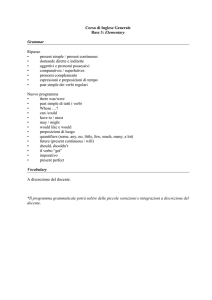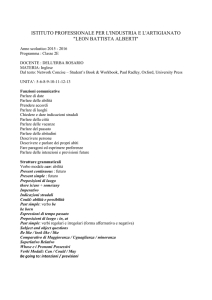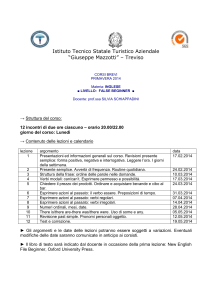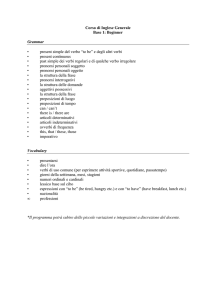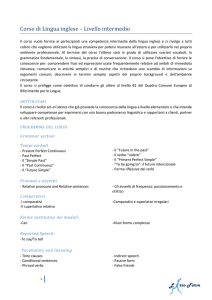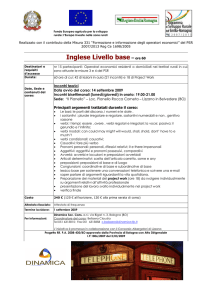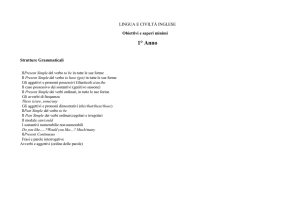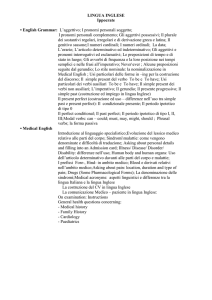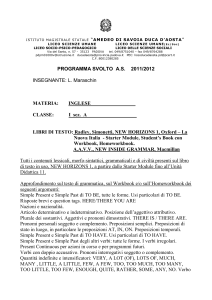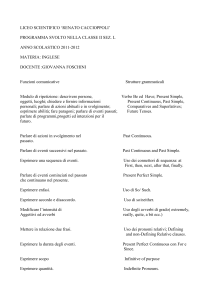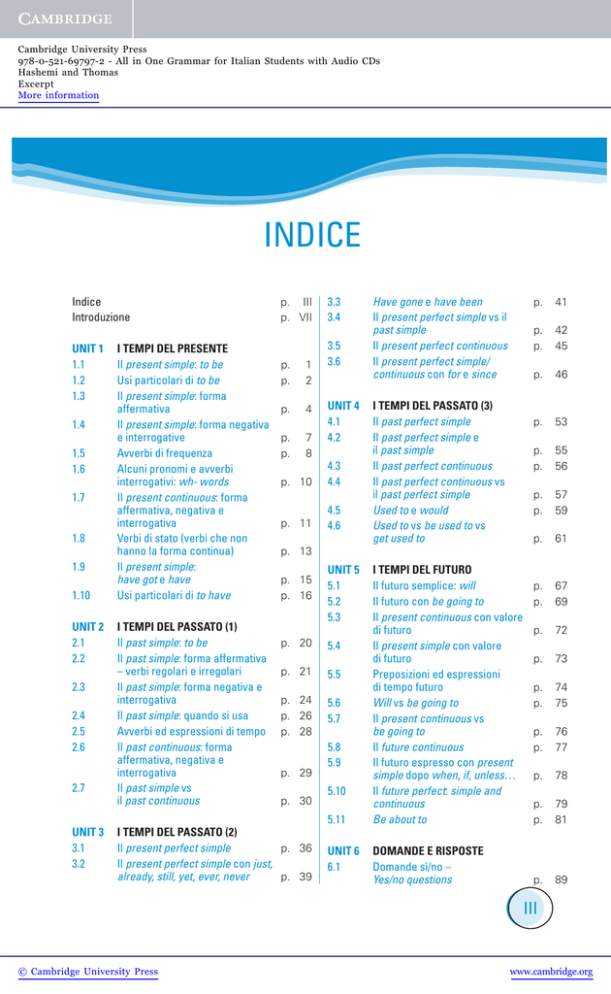
Cambridge University Press
978-0-521-69797-2 - All in One Grammar for Italian Students with Audio CDs
Hashemi and Thomas
Excerpt
More information
INDICE
Indice
Introduzione
UNIT 1
1.1
1.2
1.3
1.4
1.5
1.6
1.7
1.8
1.9
1.10
UNIT 2
2.1
2.2
2.3
2.4
2.5
2.6
2.7
I TEMPI DEL PRESENTE
Il present simple: to be
Usi particolari di to be
Il present simple: forma
affermativa
Il present simple: forma negativa
e interrogative
Avverbi di frequenza
Alcuni pronomi e avverbi
interrogativi: wh- words
Il present continuous: forma
affermativa, negativa e
interrogativa
Verbi di stato (verbi che non
hanno la forma continua)
Il present simple:
have got e have
Usi particolari di to have
I TEMPI DEL PASSATO (1)
Il past simple: to be
Il past simple: forma affermativa
– verbi regolari e irregolari
Il past simple: forma negativa e
interrogativa
Il past simple: quando si usa
Avverbi ed espressioni di tempo
Il past continuous: forma
affermativa, negativa e
interrogativa
Il past simple vs
il past continuous
p. III
p. VII
p.
p.
1
2
p.
4
p.
p.
7
8
p. 10
p. 11
3.3
3.4
3.5
3.6
UNIT 4
4.1
4.2
4.3
4.4
4.5
4.6
I TEMPI DEL PASSATO (3)
Il past perfect simple
Il past perfect simple e
il past simple
Il past perfect continuous
Il past perfect continuous vs
il past perfect simple
Used to e would
Used to vs be used to vs
get used to
p.
41
p.
p.
42
45
p.
46
p.
53
p.
p.
55
56
p.
p.
57
59
p.
61
p.
p.
67
69
p.
72
p.
73
p.
p.
74
75
p.
p.
76
77
p.
78
p.
p.
79
81
p.
89
p. 13
p. 15
p. 16
UNIT 5
5.1
5.2
5.3
p. 20
5.4
p. 21
5.5
p. 24
p. 26
p. 28
p. 29
p. 30
5.6
5.7
5.8
5.9
5.10
5.11
UNIT 3
3.1
3.2
Have gone e have been
Il present perfect simple vs il
past simple
Il present perfect continuous
Il present perfect simple/
continuous con for e since
I TEMPI DEL PASSATO (2)
Il present perfect simple
p. 36
Il present perfect simple con just,
already, still, yet, ever, never
p. 39
UNIT 6
6.1
I TEMPI DEL FUTURO
Il futuro semplice: will
Il futuro con be going to
Il present continuous con valore
di futuro
Il present simple con valore
di futuro
Preposizioni ed espressioni
di tempo futuro
Will vs be going to
Il present continuous vs
be going to
Il future continuous
Il futuro espresso con present
simple dopo when, if, unless…
Il future perfect: simple and
continuous
Be about to
DOMANDE E RISPOSTE
Domande sì/no –
Yes/no questions
III
© Cambridge University Press
www.cambridge.org
Cambridge University Press
978-0-521-69797-2 - All in One Grammar for Italian Students with Audio CDs
Hashemi and Thomas
Excerpt
More information
Risposte sì/no – Short answers
Domande introdotte
da wh- words
Domande in cui wh- word
è soggetto
Question tags: vero? / non è vero
Anch’io/neanch’io: So do I /
Neither do I
Esprimere interesse:
Do you? / Is he?
L’imperativo; let’s
6.2
6.3
6.4
6.5
6.6
6.7
6.8
UNIT 7
7.1
7.2
7.3
7.4
7.5
UNIT 8
8.1
8.2
8.3
8.4
8.5
8.6
UNIT 9
9.1
9.2
9.3
9.4
IL NOME
Il plurale
L’articolo: a(n), the e nessun
articolo
Osservazioni sull’uso degli articoli
Nomi numerabili e non
numerabili
Il possessivo del nome:
Saxon genitive / of
PRONOMI E DETERMINANTI (1)
Pronomi personali soggetto e
complemento: I e me
Aggettivi e pronomi possessivi:
my e mine
Pronomi riflessivi: myself/
yourself…
Pronomi reciproci: each other,
one another
Aggettivi e pronomi dimostrativi:
this, that, these e those;
this one, that one;
the one, the ones
There is / It is
PRONOMI E DETERMINANTI (2)
Some, any, no; any in frase
affermativa
Somebody, anybody, nobody,
everywhere, etc.
A lot of, lots of, much, many;
a little, a few
All, most, some, no e none;
all e whole
p. 91
9.5
p. 92
9.6
p. 95
p. 97
UNIT 10
10.1
10.2
10.3
10.4
10.5
10.6
p. 99
p. 100
p. 100
p. 109
10.7
p. 110
p. 113
10.8
p. 117
10.9
10.10
p. 120
10.11
p. 127
p. 130
p. 134
p. 136
p. 136
p. 139
p. 147
p. 150
p. 152
p. 154
Both, either, neither; both … and;
either … or ; neither … nor
p. 157
Each ed every; every e all
p. 159
GLI AGGETTIVI
Posizione degli aggettivi
Ordine degli aggettivi
Aggettivi in -ing/-ed
Sostantivi usati come aggettivi
Aggettivi di nazionalità
Avverbi che modificano
gli aggettivi (il superlativo
assoluto)
Comparativi e superlativi
di maggioranza
Comparativi e superlativi
irregolari
Comparativi di uguaglianza
Comparativi e superlativi
di minoranza
Comparativi: alcuni casi
particolari
p. 165
p. 166
p. 168
p. 169
p. 170
p. 172
p. 175
p. 178
p. 179
p. 181
p. 181
UNIT 11 GLI AVVERBI
11.1
Significato e formazione
degli avverbi
11.2
Avverbi irregolari
11.3
Avverbi di grado: quite, very,
fairly
11.4
Posizione degli avverbi e
dei complementi
11.5
Avverbi: comparativi
e superlative
p. 186
p. 190
p. 191
p. 192
p. 195
UNIT 12 I RELATIVI
12.1
I pronomi relativi: which, who
e that
12.2
Omissione del pronome relative
12.3
Where, when, whose e why
12.4
Frasi relative determinative
e non determinative (defining
e non-defining relative clauses)
12.5
Pronomi relativi con preposizioni
12.6
Frasi relative espresse con
il participio: a message saying…,
the people invited…
p. 202
p. 204
p. 206
p. 208
p. 211
p. 213
IV
© Cambridge University Press
www.cambridge.org
Cambridge University Press
978-0-521-69797-2 - All in One Grammar for Italian Students with Audio CDs
Hashemi and Thomas
Excerpt
More information
UNIT 13 I VERBI MODALI (1)
13.1
I verbi modali: caratteristiche
principali
p. 219
13.2
I verbi modali: potere, dovere
e volontà
p. 221
13.3
Funzioni comunicative con i modali:
Richieste – can, could,
will, would
p. 223
13.4
Funzioni comunicative
con i modali: Proposte
e suggerimenti – Shall I/we,
Why don’t you/we, Could, Let’s,
How about + -ing;
What about + -ing
p. 225
13.5
Funzioni comunicative
con i modali: Permesso – can,
could, may; be allowed to
p. 228
13.6
Funzioni comunicative
con i modali: Ordini, consigli e
raccomandazioni – must, had better,
should / ought to, could
p. 231
UNIT 14 I VERBI MODALI (2)
14.1
Capacità/abilità/possibilità:
can, could, be able to
p. 237
14.2
Obbligo o necessità: must / have to;
mustn’t e don’t have to
p. 242
14.3
Necessità e mancanza di necessità:
need, needn’t, don’t have to;
mancanza di necessità al passato: didn’t
need to do e needn’t have done
p. 246
14.4
Deduzione, certezza, possibilità,
probabilità: must, can’t, may,
might e could
p. 248
14.5
Forme composte dei verbi
modali: should have known,
could have been
p. 252
UNIT 15 IL PASSIVO
15.1
Il passivo: come si forma, quando si usa
Il passivo dei verbi con preposizione:
I was sent for; the baby was looked after
Il complemento d’agente: by
Il ‘si’ passivante:
What is this called?
p. 258
15.2
15.3
Il passivo dei verbi con
due oggetti: I was told;
they were given
To have/get something
done
p. 264
p. 265
UNIT 16 IL DISCORSO INDIRETTO
16.1
Verbo introduttivo al passato
p. 273
16.2
Futuro con will e frasi condizionali
nel discorso indiretto
p. 277
16.3
Verbo introduttivo al presente
p. 278
16.4
Elementi della frase che cambiano:
pronomi ed espressioni di tempo
e di luogo
p. 280
16.5
Say e tell
p. 281
16.6
Altri verbi usati per introdurre il discorso
indiretto: answer, remind, invite, order…;
suggest
p. 283
16.7
Domande indirette
p. 285
UNIT 17 INFINITO E FORMA -ING
17.1
Infinito come soggetto: -ing
17.2
La forma -ing e l’infinito italiano;
Verbo + preposizione + -ing:
Thank you for coming
17.3
Go/come + -ing
17.4
Infinito di scopo: I’m studying to
be a doctor
17.5
Verbi + to infinito: I decided
to go
17.6
Verbi + -ing: I enjoy drawing
17.7
Verbi + to/-ing
17.8
Make e let
17.9
Verbi + -ing o infinito senza to:
I watched them playing/play
17.10
Aggettivi + to infinito: difficult
to say
17.11
Costruzione oggettiva: want /
would like someone to do
p. 292
p. 294
p. 297
p. 298
p. 299
p. 301
p. 302
p. 305
p.307
p. 308
p. 309
UNIT 18 LE PREPOSIZIONI
18.1
Preposizioni di luogo: in, on e at; onto/off
e out of / into
p. 314
18.2
Preposizioni di luogo: under e on top of;
above/over e below/under; along,
through e round; across e over
p. 317
V
© Cambridge University Press
www.cambridge.org
Cambridge University Press
978-0-521-69797-2 - All in One Grammar for Italian Students with Audio CDs
Hashemi and Thomas
Excerpt
More information
18.3
18.4
18.5
18.6
18.7
18.8
Preposizioni di luogo: in front of,
behind, opposite, between; by,
beside e next to; between e among;
beyond e behind
p. 318
Preposizioni di tempo: at, on e in p. 320
Preposizioni di tempo:
by e until/till; in, during e for
p. 322
By, with e for
p. 324
Espressioni comuni
con preposizioni: on holiday,
in a hurry
p. 326
To be + aggettivo + preposizione p. 328
UNIT 19 I PHRASAL VERBS
19.1
Significato e forma
p. 333
19.2
Differenza tra preposizioni
e avverbi
p. 334
19.3
Verbo + preposizione: look after,
count on – posizione dell’oggetto p. 336
19.4
Verbo + avverbio: call off, back up –
posizione dell’oggetto
p. 337
19.5
Verbo + avverbio + preposizione:
get on with, come up against
p. 339
19.6
Alcuni phrasal verbs con take
p. 341
UNIT 20
20.1
20.2
20.3
20.4
20.5
20.6
20.7
UNIT 21
21.1
21.2
21.3
21.4
21.5
FRASI CONDIZIONALI (1)
Periodo ipotetico di tipo zero
Periodo ipotetico di primo tipo
Il condizionale presente: would
Periodo ipotetico di secondo tipo
Il condizionale passato:
would have
Periodo ipotetico di terzo tipo
Periodo ipotetico misto
FRASI CONDIZIONALI (2)
I wish e if only
Unless
In case
Provided/Providing that,
as/so long as
It’s time e I’d rather; otherwise
e or else
p. 348
p. 349
p. 351
p. 352
p. 355
p. 356
p. 360
UNIT 22
22.1
22.2
22.3
22.4
22.5
I CONNETTIVI (1)
Because, as e since; because of
So e therefore
To, in order to e so (that)
So e such
Enough e too
UNIT 23
23.1
23.2
23.3
23.4
23.5
I CONNETTIVI (2)
But, although e though
In spite of / Despite
Even though e even if
Both … and; either … or
When, until, before, after,
as soon as, while
Before, after, when, while
e since + -ing
Costruzioni con il participio
23.6
23.7
p. 381
p. 382
p. 384
p. 386
p. 388
p. 397
p. 399
p. 400
p. 401
p. 403
p. 404
p. 406
UNIT 24 STRUTTURE VERBALI PARTICOLARI
24.1
Verbi con costruzione personale e
impersonale: I won’t take long;
It won’t take me long
p. 413
24.2
Verbi con costruzione passiva personale
e impersonale:
They say she is very rich;
she is said to be very rich
p. 416
24.3
Inversione soggetto/verbo ausiliare:
Should you need more information,
please …;
Never had I been more surprised p. 418
24.4
Verbi da non confondere:
do e make; remember e remind;
lend e borrow
p. 421
p. 366
p. 370
p. 371
p. 373
p. 374
VI
© Cambridge University Press
www.cambridge.org

